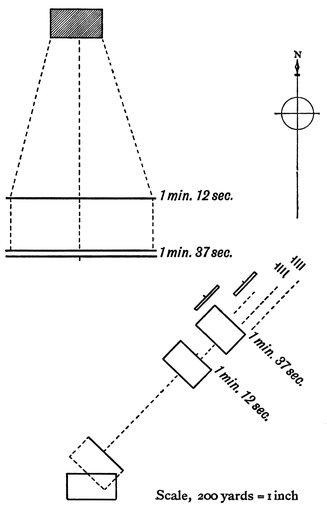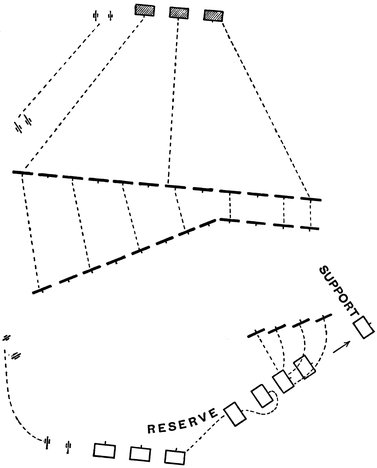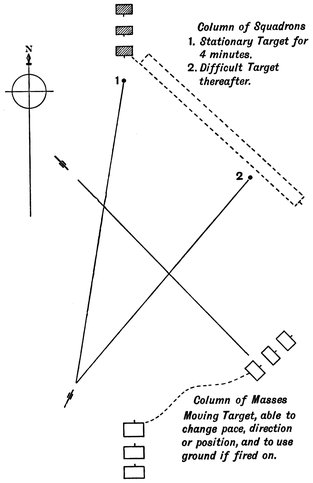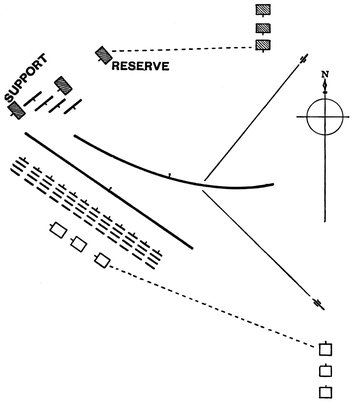“When you charge make a change of front and attack them in flank. This man?uvre can always be successfully practised against an enemy like the English, who make a vigorous and disunited charge, whose horses are not very manageable, and whose men, brave but uninstructed, begin their charge too far away from the enemy.”—De Brack.
“Ten men on the flank do more than 100 in front.”—Von Schmidt (p. 90).
I. The Squadron
1. In the mounted attack of cavalry on cavalry that side will win which makes use of a wall of mounted men, advancing knee to knee with no intervals showing. Two means of quickly forming and launching this wall are as follows: 1st. The head of the squadron column is directed towards the enemy, and line is formed to the front. 2nd. The head is led obliquely to the enemy’s advance, and at such a distance as will enable the troops to wheel into line, get up pace, and attack.
2. Forming to the Front or to the Flank.—The first plan is that which the beginner almost invariably adopts; the enemy’s squadron has a fatal attraction for him; he distrusts himself and imagines38 that there is not time to man?uvre. This attack generally “leads to undecided cavalry duels.”
The second plan is that which is always advocated, as, though it demands more sang-froid, practice, and experience on the part of the squadron leader. Its advantages are considerable; they are as follows: (a) It gives more space and consequently more time to the leader. (b) The enemy’s squadron, if already formed, will usually shoulder towards the attacker, and thus become disintegrated. (c) The movement does not entail the disorder consequent on front forming; on the contrary, a wheel into line generally ensures well-ordered and cohesive ranks. (d) The squadron is usually successful in striking the flank of the enemy.
Von Schmidt says:
An attack direct to the front must be an exceptional thing; to advance and at the same time gain ground to a flank must be the rule.
General Sir D. Haig says:
The efficacy of flank attack is so universally admitted as to need no argument to support it. A more difficult question is—how should we protect our own flanks from attack?
3. Defensive and Offensive Flanks.—Usually the best protection is afforded by either a defensive or an offensive flank; that is, a portion of the unit, say, a troop from a squadron, a squadron from a regiment, should drop back or be ready to drop back in echelon; or, on the other hand, should be thrown forward. The duty of the defensive flank is to act against an39 enemy overlapping or taking in flank the unit in front. The object of the offensive flank is to threaten even more completely than with the remaining force the flank of the enemy, who will be tempted to edge across to meet it.
What is true for a squadron is true for a regiment, and is still more true for a brigade, because with this comes in the question of artillery fire.
II. The Regiment
4. Let us then picture a regiment moving in “mass” from the south to the north of the paper, map, or ground.
Our regimental commander seeing the enemy’s mass in front and bearing down on him, say, eight hundred yards away, gives the command, “Left shoulders,” and moves N.E. The first effect is that the enemy have a moving mark to hit, and to do so must “shoulder” or change direction; while at the same time they are deploying to the front.
Both forces move three hundred yards. Then our regimental commander gives the command, “Echelon attack to the Left.” The squadron nearest to the enemy wheels into line and attacks; the remaining squadrons continue their direction and wheel into line in succession and attack as required.
The attack eventuates somewhat as in the diagram.

Diagram I.
5. Advantages of the Echelon Attack.—This form of attack has the following advantages: (a) The wheel into line, the least discomposing of evolutions,40 takes but a few seconds to carry out, and then there is presented a formed body to charge the enemy. (b) A succession of formed bodies coming up on the unprotected flank give confidence to the squadron, which feels it is supported by other lines near enough41 to catch any outflanking enemy. (c) An echelon of squadrons, seen from the enemy’s point of view at a distance of three hundred yards, is practically indistinguishable from line. It is, moreover, easier than in forming to the front to abolish all intervals between squadrons; a point of the greatest importance in an attack. (d) To be the last to form the attack from a compact formation is a considerable advantage. (e) The leader may even be able to change the direction of his mass so as to attack from due east to west.
III. The Brigade
6. Training of Leaders.—Our present squadron leaders, our future brigade and divisional leaders, must be brought up to regard this forming to the flank as the only plan, as second nature; they must believe that if they act otherwise they are voluntarily tying one hand behind their back. Otherwise the maintenance of horse artillery with a view to co-operation with cavalry is almost useless.
7. Co-operation of R.H.A.—In the cavalry fight horse artillery is the only factor which has assumed totally different proportions in the last ten years (i.e. since Q.F. guns were introduced) to those which formerly obtained. Von Schmidt, p. 163, writing in the middle of last century, says:
The co-operation of horse artillery with the shock of the cavalry must be a very exceptional occurrence, as when the circumstances of the ground are very favourable, allowing it to act and at the same time protecting it.
42 Nor does it appear that any instance of ideal co-operation between the two arms occurred in the War of 1870. With the old guns the help which horse artillery could give was not great; and consequently co-operation was not practised in peace nor attempted in war.
Strange as it may appear, our cavalry officers still find it hard not to deserve the reproach cast upon them by the Duke of Wellington, who, writing after the battle of Salamanca, remarks: “The trick our officers of cavalry have acquired of galloping at everything; they never think of man?uvring before an enemy.”
8. The Two Forms of Attack.—A brigade of cavalry which moves in mass with its guns alongside it and attacks straight to its front, masking its guns by means of its squadrons’ extensions, voluntarily throws away at least ? of its power, i.e. its guns. It will be beaten every time by the brigade which sends its guns to one of the flanks and goes to the other itself. By this last method both gun fire and charging power are fully applied. Further, it is probable the guns will be able to enfilade the enemy’s lines before they attack. A very short experience of fighting a cavalry brigade shows this conclusively, and both sides will learn to drop their guns’ trails at a favourable opportunity and move their squadrons away from them or, vice versa, the guns moving from the squadrons. The latter may be an excellent plan, and it certainly entails less wear and tear on the squadrons. Directly the guns come into action the horses can rest.

Diagram II.
The choice between the two will usually be dictated by the ground; and in most cases there will be a combination of the two. Thus a brigade is advancing towards a crest, the brigadier ahead. He sends his guns away to the high ground on one flank, and his squadrons over or round the ridge and down to the level ground on the other.
44 9. When both Forces get away from their Guns.—Both sides will usually drop the trails on the same, say, the west side, and move eastwards, opposite to each other, to attack. If working along a ridge, both sides will usually keep their guns on the higher ground.
Other things being equal, the squadrons which move farthest, fastest, and in the best order will have an advantage—(1) because they will put the enemy’s squadrons between themselves and the enemy’s gun fire; (2) because they will compel the enemy’s squadrons to form so that they are fired on by artillery and very probably enfiladed.
It becomes obvious, then, that if these tactics are adopted, and the squadrons of both sides act in exactly the same way, they will meet on perfectly level terms.
10. Formations for moving to a Flank.—The point then to aim at is to bring some deciding factor in the attack. In what formation is it best to move the squadrons away to the flank?
11. Column of Regimental Masses compared with Column of Squadrons.—Let us compare column of regimental mass with column of squadrons, and let the pace be a trot. Allow thirty seconds for the shoulder of a regimental mass, five seconds for the wheel of troops. At the end of four minutes the head of the mass will have gone 820 yards; the head of the column 920 yards. But if there are twelve squadrons, with a front of 64 yards, nine intervals of 8 yards, and two of 16 yards, the last squadron will45 have only gone 50 yards; while in the mass the rear squadron will have gone 630 yards. It follows, then, that the leader who adopted column of regimental masses practically has all his squadrons within reach of his voice, and they have moved well away from his guns.

Column of Squadrons
1. Stationary Target for 4 minutes.
2. Difficult Target thereafter.
Column of Masses
Moving Target, able to change pace, direction or position, and to use ground if fired on.
Diagram III.
46 12. Relative Effect of Artillery Fire on the two Formations.—The relative effect of the guns on the two columns may be compared. For four minutes the column of squadrons affords, before it gets on the move, a stationary though every moment decreasing mark. After that the target might be taken where the column has to pass some tree or house, and each squadron saluted in succession as it reaches this place. Otherwise it is not a very easy mark, and certainly not such a large mark as column of regimental masses, but the latter moves at once, is easily hidden, and can more easily change pace and direction.
13. Column of Masses preferred.—On the whole, the column of squadrons formation compares unfavourably with the mass formation, not only as a means of moving rapidly to a flank, but also for facility of evolution when arrived there.
14. The Formation for the Attack.—If, then, we take mass as the best formation, in what mode shall we move our mass, and evolve our lines of attack from it?
We will compare two methods. One, ours, being the echelon attack from mass to a flank, and the other, the enemy’s, being an attack to the right from quarter column. Ours only involves sufficient distance being taken between regimental masses, and we are ready to attack at once. Theirs involves the formation of lines of squadron columns and then lines, and must commence at such a distance from the enemy as to allow for the time and space used up in these two formations. For our echelon attack little47 or no ground is consumed in the direction of the enemy; and this means late formation. Consequently our mass can go on moving away from the guns for a longer period.

Diagram IV.
Another great point, directly we see him begin to open to squadron column we can give one more change to our direction, and so gain his flank. He will either be taken at an angle, or have to shoulder his line of squadron columns. Thus we have gained the outside; he must mask his own guns, and must be taken in flank by ours.
48 15. Time for Horse Artillery to unlimber.—It would appear as though the leader who first dropped his guns’ trails would be likely to win; but there is a saving clause to this. If the other side see the trails dropped in an obviously good position, they will avoid the combat there, or perhaps leave a section or portion of their horse artillery to deal with these guns, and take the remainder with them to the flank. They will avoid the cavalry combat till they are well away from the enemy’s guns, and will then fight, when they have guns and cavalry, against cavalry alone. This shows that in the cavalry combat it is a very difficult matter to know just when to drop the trails, and get away to a flank and attack. It must come as an inspiration, something like Wellington’s move at Salamanca.
16. Form of Attack must be simple.—To have to decide between a great many complicated forms of attack is out of the question. The form of attack must be simple, understood by all, and only the timing of it can be left to the leader at the supreme moment.
17. Conclusions.—Our conclusions, then, are:
1st. That it is always advisable to move diagonally to an attack coming at us, even with a squadron or regiment.
2nd. That when we have to consider the combination of horse artillery and cavalry squadrons in attack, it is still more necessary.
3rd. That the mode in which we move to a flank prior to throwing in our squadrons must be carefully49 considered, and the plan adopted which gives us most squadrons at the critical point, and the handiest and simplest mode of evolution.
4th. That intervals between squadrons are a positive evil in an attacking line.
5th. That in an echelon the supporting body must be near enough to give confidence to the body in front, far enough to catch the enemy on the turn.
6th. That no squadron must form line till it sees an enemy before it to charge. Therefore, if, as the echelon opens out, the squadron leader sees that he will be beyond the flank, he should not form to the flank, but should lead round in squadron column and look for his opportunity.
* * * * *
“Why is it,” asks Ardant du Picq, “so hard to use cavalry well?” and replies: “Because the r?le is all movement, all moral; moral and movement so closely allied, that often the movement alone without a charge, without physical action of any sort, makes an enemy retreat, and if that is followed up, causes his total rout. The latter follows from the rapidity of cavalry for those who know how to use it.”

